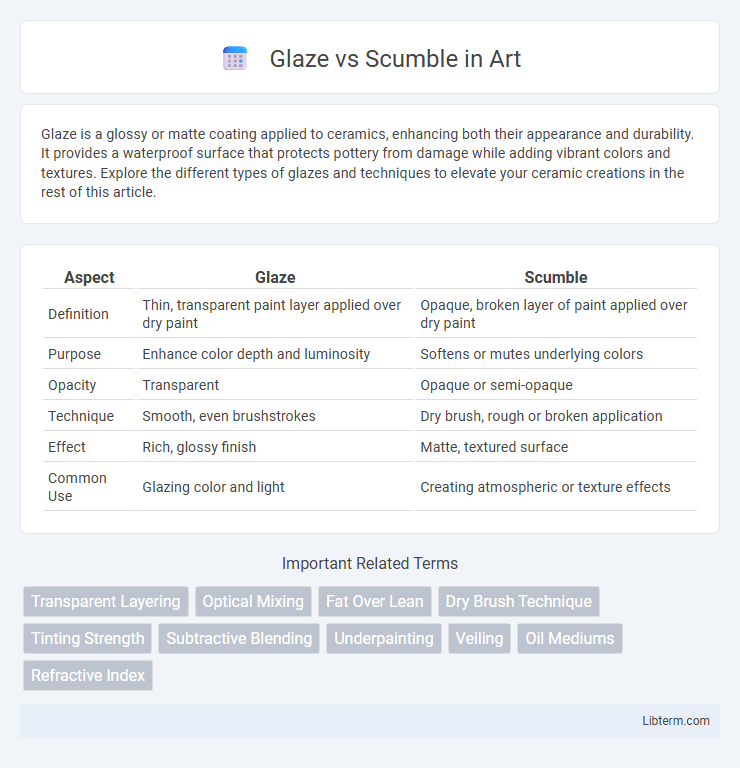Glaze is a glossy or matte coating applied to ceramics, enhancing both their appearance and durability. It provides a waterproof surface that protects pottery from damage while adding vibrant colors and textures. Explore the different types of glazes and techniques to elevate your ceramic creations in the rest of this article.
Table of Comparison
| Aspect | Glaze | Scumble |
|---|---|---|
| Definition | Thin, transparent paint layer applied over dry paint | Opaque, broken layer of paint applied over dry paint |
| Purpose | Enhance color depth and luminosity | Softens or mutes underlying colors |
| Opacity | Transparent | Opaque or semi-opaque |
| Technique | Smooth, even brushstrokes | Dry brush, rough or broken application |
| Effect | Rich, glossy finish | Matte, textured surface |
| Common Use | Glazing color and light | Creating atmospheric or texture effects |
Understanding Glaze and Scumble: Key Definitions
Glaze refers to a transparent or semi-transparent layer of paint applied over a dry layer to modify color, depth, and luminosity without obscuring underlying details. Scumble is a technique involving a thin, opaque or semi-opaque layer of lighter paint brushed lightly to soften or mute colors beneath. Understanding these definitions clarifies their distinct impacts on texture and visual effects in art, with glaze enhancing clarity and depth while scumble creates a hazy, diffused appearance.
Historical Origins and Artistic Evolution
Glaze and scumble techniques both originated during the Renaissance period, with glazing being refined by Northern European painters like Jan van Eyck who layered thin, transparent oil paint to achieve luminous depth. Scumbling emerged later, popularized by Baroque artists such as Peter Paul Rubens who applied broken, opaque layers to create texture and soften contrasts. These methods evolved through centuries, influencing Impressionist and modern painters who adapted glazing for subtle color modulation and scumbling for expressive surface effects.
Core Techniques: How Glazing Works
Glazing works by applying thin, transparent layers of paint over a dry base layer to modify color, enhance depth, and create luminosity without covering the underlying details. This core technique relies on the light passing through each glaze layer and reflecting off the opaque base, producing a rich, glowing effect often seen in oil and acrylic painting. In contrast, scumbling involves applying a lighter, more opaque layer with a dry brush to soften or lighten areas, serving a different textural and visual purpose.
Core Techniques: How Scumbling Works
Scumbling involves applying a thin, opaque layer of paint over a dry underlayer, allowing the texture and colors beneath to partially show through, creating a soft, textured effect. This core technique relies on a dry brush with a minimal amount of paint to build subtle transitions and atmospheric depth. Unlike glazing, which uses transparent layers to enhance color richness and luminosity, scumbling emphasizes opacity and texture to add dimension and visual interest to a painting.
Visual Effects: Transparency vs Opacity
Glaze creates a transparent layer that enhances depth and luminosity by allowing underlying colors to show through, making it ideal for subtle color shifts and smooth transitions. Scumble produces a more opaque, textured effect by applying a lighter, semi-dry layer over a darker background, resulting in a matte finish with visible brushstrokes. The choice between glaze and scumble significantly affects visual impact, as glaze emphasizes clarity and shine while scumble emphasizes surface texture and muted tones.
Common Materials and Mediums Used
Glaze typically uses transparent oil-based or acrylic mediums mixed with pigments, allowing light to pass through layers and create depth on the canvas. Scumble employs semi-opaque or opaque pigments thinned with mediums like linseed oil, acrylic medium, or solvent to create a broken, textured effect over dry layers. Both techniques rely on carefully selected binders and mediums to enhance the interaction between layers, but glaze emphasizes clarity and luminosity, while scumble focuses on texture and opacity.
Best Surfaces for Glazing and Scumbling
Glazing works best on smooth, non-porous surfaces like primed canvas, sealed wood, or glass, which allow thin, transparent layers of paint to build luminous depth and richness without absorption. Scumbling is ideal on textured or rough surfaces such as coarse canvas or heavily gessoed panels, where dry, opaque paint can snag the surface texture and create broken, visually dynamic effects. Both techniques benefit from compatible surface preparation to optimize paint adhesion and achieve the intended optical qualities.
Applications in Oil, Acrylic, and Watercolor
Glaze and scumble techniques differ in application and effect across oil, acrylic, and watercolor painting. In oil painting, glazes involve thin, transparent layers of diluted paint to enhance color depth and luminosity, while scumbling uses a dry, opaque, or semi-opaque layer to create texture or soften edges. Acrylic artists often employ glazing to achieve rich, layered hues with slow-drying mediums, whereas scumbling in acrylics adds a chalky or broken color effect; watercolor glazing builds multiple translucent washes to develop tonal variation, and scumbling appears as a dry brush technique imparting rough, textured marks.
Artistic Styles Suited for Glaze and Scumble
Glaze techniques are highly effective for creating luminous, transparent layers that enhance realism and depth in classical and Renaissance painting styles, allowing artists to build rich, subtle color transitions. Scumbling, characterized by its opaque, broken application of lighter tones over darker layers, suits impressionistic and abstract styles by adding texture and atmospheric effects without full coverage. Both techniques contribute unique visual qualities, with glaze emphasizing smooth color harmony and scumble enhancing tactile surface variation.
Choosing the Right Method for Your Artwork
Glaze and scumble are essential painting techniques that influence texture and depth in artwork, with glaze applying transparent layers to enhance color richness and scumble using opaque, broken layers for softening or toning. Choosing the right method depends on the desired visual effect; glaze is ideal for achieving luminosity and subtle color shifts, while scumble creates a matte, textured surface with a more tactile feel. Artists should consider the underlying paint's drying time and color interaction to ensure harmony and effectiveness in their final piece.
Glaze Infographic

 libterm.com
libterm.com